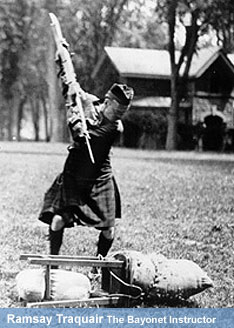
|
|
|
PEDAGOGUE Ramsay Traquair was appointed Professor of Architecture at the McGill School of Architecture in 1913. The following year, he received the title of Macdonald Professor of Architecture, succeeding Percy Nobbs. During the first four years of his tenure as Director, Traquair introduced an altered curriculum of the newly extended five-year program. The core teaching staff consisted of architects (Nobbs, Burgess, Turner, Ludlow, Forbes, Cormier, Careless, Thomson, Dyonnet), engineers (Armstrong, Mattice, Beullac, Lamb), and a sculptor (Hebert). Traquair overhauled the program structure by eliminating several courses, and introduced a new course in design. He himself taught the four history courses offered: Classical, Medieval, Renaissance, and Modern. Traquair's teaching was heavily influenced by his training in archaeology and palaeogeography. This and his affinity with the Arts and Crafts movement emphasized the attention to detail and the use of material in design. Growing up in the Arts and Crafts milieu, Traquair stressed the importance of craftsmanship, proportion, symmetry, and rhythm. In his address The Education of the Architect, delivered to the RAIC in 1919, he spoke about the need of architects to have a wide knowledge of literature, historical and artistic traditions of the past, as well as have a certain command of accurate description in drawing. Traquair went on to say that three types of training were necessary for a well-rounded and able architect: artistic (archaeology and design); scientific (engineering, building construction, and legal aspects); and office management (working and building operation). Office training is the only one aspect the University cannot supply, therefore he urged the university and the architect offices to collaborate in the training of future generation of architects. In another address on architectural education, given at the 21st Annual Meeting of the RAIC in Ottawa in 1928, Ramsay Traquair opposed the standardization in education, the topic of discussion. He suggested that travelling scholarships were a goal to aim for, including the exchange of lecturers between universities to gain a wider appreciation of common ideals. In the article entitled "Objectives of Architectural Education" [The Architectural Record, Nov. 1933], Traquair stated that the practical requirements are to be looked upon as opportunities, not limitations: "Every real work of architecture is based on practical needs, placed upon an actual site and composed of real materials..." and "art like everything else grows from the past". In 1915, Ramsay Traquair established the Architectural Association of
McGill, and the following year he founded a series of travelling scholarships
enabling studies in Europe for three months. The changes institutionalized
by Traquair with respect to the architectural curriculum allowed the department
to be recognized by the Royal Institute of British Architects (RIBA).
In 1921, summer school in sketching and measuring was established, a tradition
still followed today. In the McGill Annual Reports for 1917-1918, it is
noted that "The staff of the Department of Architecture is actively
collecting drawings and photographs (see John Bland's Introduction to
the Traquair Archive) of historic buildings in Canada, with the object
eventually of forming a record of the older architecture of the Dominion,
and particularly of the Province of Quebec." This budding architectural
archive was enhanced by Ramsay Traquair's purchase in 1918 of the C.T.
Hart collection of old [architectural] photographs dating from the 1880s
and served as a foundation of Traquair's publication The Old Architecture
of Quebec (1947). In addition to the Hart Collection, Montreal architect
A.C. Hutchison donated c.1500 lantern slides in 1920 to the Department
of Architecture, including views of old buildings. During the years 1918-1933, Traquair and his students participated in the Spring Exhibitions at the Art Association of Montreal (Montreal Museum of Fine Arts) and also at the Annual Exhibitions of the Royal Canadian Academy of Arts showing photographs, watercolours, architectural drawings, and woodcuts. Traquair was deeply interested in wood carvings, silver and metal works, and designed Flags for the Boy Scouts. He possessed sufficient knowledge on mural artistry from his collaborations with his mother, Phoebe, to give lectures entitled Mural Decoration, Wall Painting vs. Panel Pictures, Two Imaginative Artists: William Blake and David Scott, Block Printing, and Wood Cuts. An honorary M.A. was bestowed upon Ramsay Traquair from McGill University in 1923. In the same year, Traquair became a founding member of the McGill Faculty Club and was elected its president in 1934. In the McGill University Publication Series XIII [Art and Architecture No.1-41], 22 of them were written by Traquair, either alone or in collaboration with C.M. Barbeau, E.R. Adair, and G.A. Neilson. In 1925, Traquair's academic efforts were rewarded by RIBA's recognition of the Department of Architecture. Upon his retirement from the Directorship in the School of Architecture in 1939, Ramsay Traquair was presented with an award by the Province of Quebec Association of Architects and was appointed Emeritus Professor of Architecture. Percy Nobbs delivered an address for his colleague's retirement, P.R. Wilson wrote a special poem, and Frederick Taylor painted his portrait that now hangs in the Blackader-Lauterman Library of Architecture and Art. Ramsay Traquair also retired from the Council of the Art Association of Montreal after more than 20 years of service.
|
|
next biographical section: historian>>
|
|
Digital Collections | © 2003, McGill
University
|
| Poem written by P. R. Wilson and read on the occasion of Ramsay Traquair's
retirement, May 5, 1939
The Heavens weep with rain (or snow), |